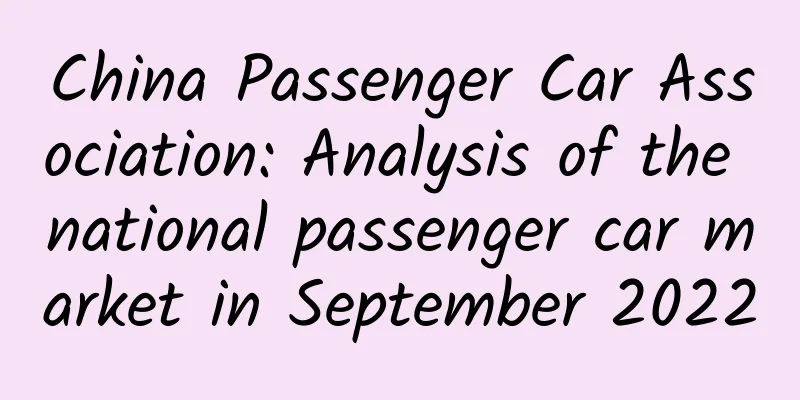China Passenger Car Association: Analysis of the national passenger car market in September 2022

|
1. Review of the national passenger car market in September Retail: In September 2022 , the retail sales of passenger cars reached 1.922 million units, a year-on-year increase of 21.5% , a rapid growth; in September , retail sales increased by 2.8% month-on - month, and the month-on-month growth rate was at a historical low in the same period in the past 20 years. From January to September , the cumulative retail sales reached 14.875 million units, a year-on-year increase of 2.4% , a year-on-year net increase of 355,000 units, of which the year- on-year net increase from June to September was 1.43 million units, which contributed greatly to the increase. In September this year , the spread of the COVID-19 epidemic continued to be effectively contained across the country. In September, 5,516 confirmed cases were reported in 28 provinces across the country, a decrease of more than half from 12,093 cases in 28 provinces in August; 25,040 asymptomatic cases were reported in 29 provinces across the country in September , a significant decrease from 37,366 cases in 29 provinces in August . Although the number of infections decreased from August , the main epidemic area in August was Hainan, not a province with large automobile consumption; in September , the epidemic area spread to several provinces, and there were provinces with large automobile consumption, such as Sichuan, so the month-on-month growth rate was slightly slower. The impact of the epidemic on the overall auto market still needs attention. Due to the continuous improvement of logistics and supply chain after the epidemic in May , the channel inventory is sufficient, which has effectively and steadily promoted the growth of the auto market. Under the ultra-low base of last year's chip supply interruption, the national passenger car retail sales increased by 21.5% year-on-year in September , a slight decline from the growth rate of 29% in August , among which the preferential policy measures of car purchase tax have gradually shown their effects. In September , the promotion intensity of the auto market remained high, and mainstream automakers all increased their promotional activities in an effort to make up for the sales losses caused by the epidemic in the early stage and strive for the best results in achieving the expected quarterly targets. In September , the retail sales of luxury cars reached 290,000 units, up 45% year-on-year and 15% month-on-month . The policy of halving the car purchase tax has greatly promoted high-end consumption in consumption upgrades. In September , domestic brands sold 890,000 vehicles, up 28% year-on-year and 5% month-on-month . In September , the domestic retail share of domestic brands was 47.0% , up 2.7 percentage points year-on-year; the cumulative share from January to September was 47.0% , an increase of 7.5 percentage points over the same period in 2021. In September , the wholesale market share of domestic brands was 50.4% , an increase of 2.6 percentage points over the same period last year ; the cumulative share of domestic brands from January to September was 48.0% , an increase of 5.3 percentage points over the same period in 2021. Domestic brands have gained significant growth in the new energy market, and leading companies have performed well. The brand share of traditional automakers such as BYD Auto, Changan Automobile, Chery Automobile, and Geely Automobile has increased significantly. In September , mainstream joint venture brands sold 740,000 vehicles, up 8% year-on -year and down 4% month-on-month . In September , the retail share of German brands was 21.0% , up 1.5 percentage points year-on-year, and the retail share of Japanese brands was 17.7 % , down 3.1 percentage points year-on-year . The market share of American brands was 10.7% , down 0.5 percentage points year-on-year. Exports: In September , the export of passenger cars (including complete vehicles and CKD ) under the statistical caliber of the China Passenger Car Association reached 250,000 units, an increase of 85% year- on-year and a decrease of 6% month-on-month . In September , new energy vehicles accounted for 18.4% of the total exports . In September , the export of domestic brands reached 204,000 units, an increase of 88% year-on-year and 13 % month-on-month from August ; joint venture and luxury brands exported 34,000 units, an increase of 60% year-on-year . From January to September, the cumulative export of passenger cars was 1.59 million units, an increase of 60% . Domestic brands have made comprehensive breakthroughs in exports to the European and American markets and third world countries, and the export strategy of international brands' China bases is also increasingly reflected. Production: In September , passenger car production reached 2.357 million units, up 37.0% year-on-year and 11.2% month-on-month . The supply guarantee measures of the industrial chain have been effective. Among them, the production of luxury brands increased by 55% year-on-year and 3% month-on-month; the production of joint venture brands increased by 20% year-on-year and 6% month-on-month ; the production of independent brands increased by 47% year-on-year and 18 % month-on-month . From January to September , the production of automobile companies reached 16.865 million units, up 18.0% year-on-year . In September , major enterprises increased production vigorously, with BYD Auto, FAW-Volkswagen, and SAIC-GM-Wuling all achieving a month-on-month growth of more than 17% . In August , due to the continuous high temperature and little rain, power was restricted. In September , Changan Passenger Vehicle increased production by 85% month -on- month . Wholesale: In September , the wholesale sales of manufacturers reached 2.293 million vehicles, a year- on-year increase of 32.0% and a month-on-month increase of 9.4% . Driven by the new energy market, the performance of some automakers was obviously differentiated. From January to September , the wholesale sales of manufacturers reached 16.699 million vehicles, a year-on-year increase of 14.4% . BYD Auto, FAW-Volkswagen and Chery Automobile, which are the manufacturers with the highest sales volume, are also the top three contributors to the growth compared with September last year . GAC Toyota and FAW Toyota also have strong growth. Inventory: Production and sales in September were not as smooth as in August , resulting in a push-type production and sales trend in which manufacturers' output was 60,000 vehicles higher than wholesale and manufacturers' domestic wholesale was 130,000 vehicles higher than retail . The growth in manufacturers' wholesale from May to September laid the foundation for the strong growth in retail at the end of the year. Since the fourth quarter of 2021 , manufacturers' inventories have been replenished rapidly. From January to September 2022 , the cumulative inventory replenishment was nearly 170,000 vehicles, of which the inventory replenishment from May to September was relatively large. Since the purchase tax halving policy was implemented in June , the incremental contribution of manufacturers' inventory has been relatively large since May . In September , manufacturers' inventories increased by 60,000 vehicles month-on- month , and the cumulative increase from January to September was 170,000 vehicles. From January to September 2021 , manufacturers' inventories decreased by 300,000 vehicles. This year's manufacturers' inventories have improved significantly. In September , channel inventory increased by 130,000 vehicles month-on- month , and channel inventory increased by 230,000 vehicles from January to September , which is in sharp contrast to the decrease of 900,000 vehicles from January to September 2021 . The global epidemic has caused severe shortages, and it is a rare achievement for China's auto market inventory to recover to a medium-to-high level, laying a stable foundation for exports and domestic sales. As inventory is guaranteed, terminal retail sales in early September have significantly strengthened under policy promotion, and exports of domestic brand passenger cars also hit a record high of 204,000 in September . New energy: In September , the wholesale sales of new energy passenger vehicles reached 675,000 units, a year-on-year increase of 94.9% and a month-on-month increase of 6.2% . After the introduction of the policy of halving the vehicle purchase tax, new energy vehicles were not only not affected, but also continued to improve month-on-month, exceeding expectations. From January to September , the wholesale sales of new energy passenger vehicles reached 4.341 million units, a year-on-year increase of 115.4% . In September , the retail sales of new energy passenger vehicles reached 611,000 units, a year- on-year increase of 82.9 % and a month-on- month increase of 14.7%. From January to September, a trend of upward trend was formed. From January to September , the domestic retail sales of new energy passenger vehicles reached 3.877 million units, a year-on-year increase of 113.2% . In the new energy vehicle market, the supply improvement and the expectation of oil price increase have brought about a hot market. The oil price has risen while the electricity price has been locked, which has led to a hot performance in electric vehicle orders. The month-on - month trends of new energy vehicles and traditional fuel vehicles in September were significantly driven by policies. The policies introduced by various regions to encourage consumption are strong, and the production of mainstream automakers has continued to increase, which has changed the off-season pattern and further boosted the hot auto market in September . 1) Wholesale: In September , the wholesale penetration rate of new energy vehicle manufacturers was 29.4% , an increase of 9.5 percentage points from the penetration rate of 19.9% in September 2021. In September , the penetration rate of new energy vehicles of independent brands was 47.9% ; the penetration rate of new energy vehicles in luxury cars was 29.1% ; and the penetration rate of new energy vehicles of mainstream joint venture brands was only 3.9% . In September , the wholesale sales of pure electric vehicles were 507,000 units, a year-on-year increase of 76.3% ; the sales of plug-in hybrid vehicles were 168,000 units, a year-on-year increase of 186.4% . In September , the sales of Class B electric vehicles were 139,000 units, a year-on-year increase of 58% and a month-on-month increase of 3% , accounting for 27% of the pure electric share . In the pure electric market, the A00+A0 economy electric vehicle market has risen, among which the A00- class wholesale sales volume was 122,000 units, a decrease of 5% month-on-month , accounting for 24% of the pure electric market share; the A0- class wholesale sales volume was 101,000 units, accounting for 20% of the pure electric market share; the A- class electric vehicles accounted for 26% of the pure electric market share ; and the B- class electric vehicle sales volume still led the way. In September , new energy vehicles with a starting price of less than 100,000 yuan accounted for 25% , down 6 percentage points from September last year ; those with a starting price of 100,000-200,000 yuan accounted for 44 % , up 8 percentage points; those with a starting price of 200,000-300,000 yuan accounted for 24% , down 1 percentage point; those with a starting price of 300,000-400,000 yuan accounted for 5% , down 1 percentage point; and those with a starting price of more than 400,000 yuan accounted for 2% , remaining stable. In September , Model Y sales reached 51,802 units, BYD Song sales reached 46,475 units, and Wuling Hongguang MINI sales reached 44,711 units, ranking the top three in overall passenger car sales. 2) Retail: In September , the domestic retail penetration rate of new energy vehicles was 31.8% , an increase of 11 percentage points from the penetration rate of 21.1% in September 2021. In September , the penetration rate of new energy vehicles among independent brands was 55.2% ; the penetration rate of new energy vehicles among luxury cars was 29.7% ; and the penetration rate of new energy vehicles among mainstream joint venture brands was only 4.2% . From the perspective of monthly domestic retail share, in September , the retail share of new energy vehicles of mainstream independent brands was 67% , an increase of 9.2 percentage points year-on-year; the share of new energy vehicles of joint venture brands was 5.7% , a decrease of 3.3 percentage points year-on-year; the share of new forces was 14.6% , a decrease of 2.9 percentage points year-on-year; and the share of Tesla was 12.7% , a decrease of 2.9 percentage points. 3) Export: In September , 44,000 new energy passenger vehicles were exported . With the support of the resumption of work and production policy under the epidemic, more and more Chinese-made new energy product brands have gone abroad. With the continuous improvement of overseas recognition and the improvement of service networks, the market prospects continue to improve. In September , the new energy exports of various automakers were as follows: SAIC Passenger Vehicle 15,509 vehicles, BYD Auto 7,736 vehicles , Tesla China 5,522 vehicles, SAIC-GM-Wuling 4,123 vehicles, Geely Auto 2,364 vehicles , Dongfeng Peugeot Citroen Automobile 1,583 vehicles, Dongfeng EasyGo 1,419 vehicles, Dongfeng Xiaokang 1,266 vehicles, Skyworth Automobile 1,149 vehicles , Great Wall Motors 796 vehicles, Ai Chi Automobile 715 vehicles, Dongfeng Passenger Vehicle 483 vehicles , FAW Hongqi 475 vehicles , JAC Motors 404 vehicles, and the export of new forces has also gradually started recently. 4) Car companies: The new energy passenger car market hit a record high in September . BYD Auto's pure electric and plug-in hybrid dual-drive strategy has consolidated the leading position of its own brand in new energy; traditional car companies represented by Chery Group and GAC Group have performed quite well in the new energy sector. In terms of product launch, as independent car companies have taken multiple approaches to new energy, the market base continues to expand. There are 15 companies with wholesale sales exceeding 10,000 vehicles (down 1 from the previous month and up 7 from the previous year), accounting for 83.2% of the total new energy passenger car sales . Among them: 200,973 BYD Auto , 83,135 Tesla China, 52,377 SAIC-GM-Wuling , 39,227 Geely Auto , 30,016 GAC Aion , 28,574 Changan Automobile , 23,433 SAIC Passenger Car , 20,508 Chery Automobile , 18,005 Nezha Auto , 11,531 Li Auto, 11,039 Leapmotor , 10,878 NIO , 10,770 FAW-Volkswagen , 10,368 Great Wall Motors , and 10,101 Jinkang New Energy . 5) New forces: In September , the retail share of new forces was 13.5% , down 3.4 percentage points year-on-year; the sales of new forces such as Nezha, Ideal, Leapmotor, Weilai, Xiaopeng, and Weimar Motors were still strong year-on-year and month-on-month, especially Nezha and Leapmotor in the second camp, which is also an advantage in the segmented market track. Among the mainstream joint venture brands , Volkswagen South and North are in the lead, with 16,383 new energy vehicles wholesaled, accounting for 51% of the mainstream joint venture pure electric vehicles . Volkswagen's firm electrification transformation strategy has begun to bear fruit. Other joint ventures and luxury brands still need to make efforts. 6) General hybrid: In September , the wholesale volume of general hybrid passenger cars was 79,998 units, up 39% year-on-year and flat month-on-month. Among them, Toyota sold 50,638 units, Honda sold 15,872 units, Dongfeng Passenger Vehicle sold 5,145 units, GAC Passenger Vehicle sold 2,988 units, Geely Automobile sold 2,517 units, Dongfeng Nissan sold 1,437 units, and Lynk & Co sold 1,259 units. The independent brands of hybrid cars are gradually becoming stronger in the process of cultivation. 2. Outlook for the national passenger car market in October 2022 There are 18 working days in October , one more day than in October last year . Some car companies have also adjusted their production rhythm this year, which is conducive to production growth. At present, the inventory of fuel vehicles is gradually sufficient, the production constraints have been improved, and the problem of poor delivery of best-selling models has gradually eased. There are fewer activities that attract people to the auto market recently, such as auto shows, and consumers are not very enthusiastic about traveling and visiting stores, so they mainly rely on natural customer growth. Travel has been blocked in some areas due to the impact of the epidemic, and store customer flow has been affected to a certain extent. However, since schools in some areas have notified in September that the " National Day " holiday will be shortened to three days, some order demands will be postponed to subsequent months accordingly. As the weather turns colder and the autumn harvest is completed, car-buying enthusiasm in rural areas will gradually be released, and the market for new energy vehicles and mid- and low-end fuel vehicles will gradually heat up. The appeal of new automobiles continues to increase. From January to September 2022 , a total of 439 fuel-powered models were remodeled or replaced, of which the average number of remodeled or replaced models per month was 42 from January to May , 48 in June , 53 in July , 82 in August , and 44 in September . From July to September, some models were intensively remodeled, with additional features and price cuts, optimized appearance and enhanced intelligence, such as standard L2 assisted driving system and intelligent cockpit, which greatly improved the product appeal. From the perspective of real estate, despite the recent strong positive news such as tax exemption for trade-ins and interest rate cuts, the National Day consumption in the property market is still extremely unpopular, and low-tier cities are still in the stage of digesting inventory. Therefore, consumer confidence in the related industrial chain is not strong, and it does not boost short-term consumer confidence in the auto market much. As OPEC's crude oil production cuts have led to oil prices stabilizing at mid-to-high levels, and the Federal Reserve's interest rate hikes have led to a cooling of the world economy, the Chinese export market will find it difficult to continue its previous boom due to its high base level in the past, and its boost to the auto market will be weakened. As the implementation of the halving of the car purchase tax policy enters the countdown stage, potential consumers' attention to car purchases has increased significantly, while car prices are still low, and consumers are not in a hurry to buy cars. Car prices may enter a promotion contraction period in October as usual. In the future, the continued high sales at the end of the year before the policy is withdrawn will further reduce the promotion efforts, so October is the best time to buy a car. 3. China's auto exports have obvious high-end characteristics of new energy
In 2022 , China's automobile exports showed explosive growth. Before 2020 , it basically maintained at a level of about US$ 15 billion, rose to US$ 32.3 billion in 2021 , and reached US$ 31.4 billion in January-August 2022. From the average price of automobile exports, the average price was US$ 12,900 in 2018 , and then gradually increased to US$ 16,400 in 2022 , and reached US$ 18,900 in August 2022. The main reason for the export growth is the surge in exports of new energy vehicles, and both the export volume and average price have grown strongly. The average export price of gasoline vehicles has basically remained at around $ 12,000 , diesel vehicles at around $20,000, and plug-in hybrid vehicles at around $ 29,000 . The average export price of pure electric vehicles has increased significantly, from $ 2,000 in 2018 to $ 11,000 in 2020 , reaching $ 19,900 in 2022 , and reaching a good level of $ 25,800 in August . The RMB exchange rate against the euro has appreciated rapidly recently, from 7.61 yuan to 6.92 yuan in September 2021 , and the RMB has appreciated by 9% against the euro . With the rapid technological progress of independent brand new energy vehicles, Chinese independent brand new power car companies have recently entered the European market in a high-profile manner, and companies such as BYD Auto have also increased their expansion in overseas markets such as Japan. This has also fully utilized the industrial chain advantages of China's electric vehicles, achieved an improvement in export levels, stable prices and high quality, and is conducive to expanding the market scale and driving the transformation and upgrading of China's manufacturing industry. 4. The trend of complete vehicle being king will definitely return With the release of the interim reports of listed companies, the performance of lithium mining companies and battery companies is generally good, especially the performance of lithium mining companies is super strong. The net profit margin of lithium mining turnover of leading companies is about 70% , and the profit margin of upstream battery companies is about 8% , while the profit margin of vehicle companies is about 5% . The profit of the automobile industry is already low in the downstream manufacturing industry. The madness of the lithium mining industry today is mainly due to the rapid development of the new energy vehicle industry and the resource mismatch caused by the increase in expectations, as well as the opportunities brought by environmental protection. However, in the future, the whole vehicle will be king, and the whole vehicle enterprises will become the " chain leader " of the industrial chain . After the whole vehicle integrates the key industrial chain, the pricing power will continue to increase. The parts do not have a continuous industrial chain pricing power. Even those whole vehicle enterprises that cannot make chips by themselves are also characterized by the whole vehicle being king. Battery enterprises will inevitably face various constraints from whole vehicle enterprises, such as making some batteries and core parts by themselves, and outsourcing some parts. In the future, if companies that make new energy vehicles want to be profitable, it is very important to have the ability to control the industrial chain. In particular, battery products must be controlled by themselves, just like companies that make fuel vehicles must control the engine, otherwise they will be controlled by battery suppliers. Batteries are the biggest cost of electric vehicles, and their performance structure has a great impact on key indicators such as charging and discharging. At the same time, whether the battery industry is manufactured and controlled is related to a series of industries such as after-sales, recycling, and reuse. Vehicle manufacturers are the ones who care most about consumer interests. Only by safeguarding consumer interests and achieving the best cost and most economical model to meet user needs can the scale of the vehicle market achieve sustainable development. The characteristic of the industrial chain is that it is related to both the upstream supply chain and the terminal market, and is in the middle of the bargaining position between the two ends, so how to maintain profitability is relatively complex; and profitability will directly affect the development of enterprises and promote the sustainability of consumption, so the characteristics of the whole vehicle being king in the era of fuel vehicles will surely be repeated in the era of electric vehicles. At present, excellent companies such as BYD Auto and Tesla have already demonstrated such characteristics, and companies such as GAC Group, SAIC Group, Great Wall Motors, and Geely Auto are also beginning to make such efforts. The development of China's automobile industry will be stronger. 5. The combination of distribution channels from the perspective of consumer electronics channels With the rapid development of the electric vehicle market, the sales model of electric vehicles has changed from mechanical products to durable consumer goods. At present, mature durable consumer goods and traditional cars are basically based on diversified distribution models, and the direct sales model is unlikely to become the mainstream model in the car market. The recent launch of Apple's new products shows the channel combination characteristics of the world's high-end digital products. Due to the lack of innovation in its mobile phones, the market popularity is low, and the price changes rapidly, the diversified advantages of channels such as official websites, direct stores, e-commerce platforms, and specialty stores are fully reflected. These channels have obvious differences in the allocation of new product resources, after-sales policies, and price changes. At present, the electric vehicle market is developing rapidly. Most electric vehicles have not yet completed the unsalable elimination cycle. The market changes in the future should be faster. Electric vehicle marketing should learn from the survival methods of products that have experienced ups and downs. The direct sales model has a huge price rigidity problem, which will inevitably affect sales. Production and scale are the most important. Price serves sales, so electric vehicle sales channels need to be effectively supplemented and improved. Retaining the authorization model on the basis of the current offline direct sales, online direct sales, and supermarkets is a basic guarantee for market sales. 6. Increased replacement purchases are the core growth driver of the auto market As China's population peak has reached its peak and the young population is gradually decreasing, China's auto market has entered a new development period dominated by the middle-aged and elderly. From Xiali becoming the sales champion in 2005, to A - class cars such as Lavida and Sylphy becoming the sales champion after 2010 , Wuling Hongguang MINI has recently become the new sales champion. With the rise of the second car in the family and the female car-buying group, the demand for replacement and additional purchases in the car market has become the core driving force for the development of the car market. Years of rapid economic growth have led to the rapid growth of China's middle-class families, which has also led to the accelerated growth of additional replacement demand. Young people are generally under heavy debt burden, so tapping the consumption potential of the existing middle-aged and middle-aged and elderly consumer groups is an opportunity for the development of auto companies. At present, it is judged that the development potential of young consumer groups is relatively small, and they are not the mainstream development power of fuel vehicles. In addition, young people's first car is mostly bought by their parents, so the car models they choose are mainly mature and stable. Therefore, the performance of young models is not particularly ideal at present, while the corresponding electric models are growing at a very high speed and the performance of mid-to-high-end cars is relatively strong. The policy of halving the purchase tax for fuel vehicles below 2.0 liters that we recently launched is to meet the demand for replacement purchases, so it will achieve better results. |
<<: 2024 Xiaopeng P5 Buying Guide: Which Model Should You Choose Between Plus and Pro?
Recommend
Olympic gold medals are not pure gold anymore! They are made of garbage and old building materials! Countries have started a garbage competition...
The athlete who won an Olympic medal at the Paris...
Battlefield 1 PS4 Edition Review: A Dream Return to the First World War: Old Soldiers Remain Undead and Pick Up Guns Again
In the golden month of October, Battlefield 1 was...
Nutritionist's special reminder! Zibo barbecue is delicious, but you need to follow these 8 points to eat it healthily!
As the weather warms up, the barbecue industry ha...
Samsung: Samsung's QD-OLED panel shipments will increase by more than 50% in 2025, with a market share of 71.2%
Recently, Samsung announced plans to increase shi...
Movies and TV shows show people vomiting blood in various ways... Is it really reasonable?
An actor's self-cultivation includes not only...
I am lactose intolerant to milk, so what about oat milk?
Milk is a drink called white blood. As a natural ...
No chicken can leave Guangdong alive, and no fruit in Beijing is not made into dried fruit.
It is said that "after Laba Festival it is t...
Huawei AppGallery Connect Salon Guangzhou Station successfully concluded
On December 18, the Huawei AppGallery Connect Stu...
Analysis of community group buying operation logic!
Preface: At present, with the entry of giants suc...
Baidu snapshot hijacking tutorial, sharing of real cases of Baidu snapshot hijacking!
Maybe some friends still don’t know what “Baidu s...
Chen Aiguo: 10 Lectures on Child Psychoanalysis
Chen Aiguo: 10 Lectures on Child Psychoanalysis R...
How was China’s “Plant Pompeii” “built”?
According to Xinhua News Agency on September 3, t...
Realme X review: Redmi killer or cheap Reno?
The mobile phone market in the first half of this...
Heavy rain in the south and cold weather in the north, what’s wrong with the weather in May?
Heavy rainfall has continued in the south in rece...
How much does it cost to join a course and purchase a mini program in Fangchenggang?
Why join the WeChat Mini Program Development Comp...









